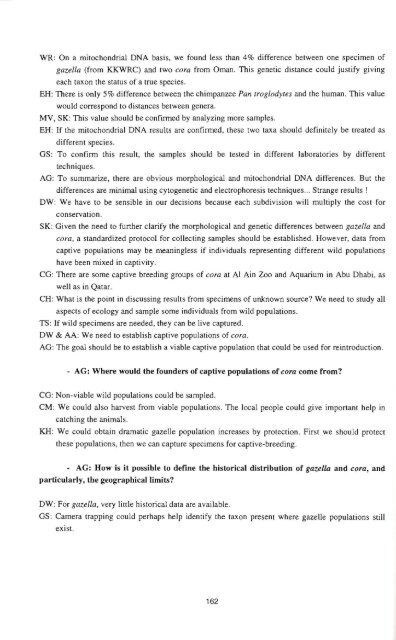CONSERVATION OF ARABIAN GAZELLES - Nwrc.gov.sa
CONSERVATION OF ARABIAN GAZELLES - Nwrc.gov.sa
CONSERVATION OF ARABIAN GAZELLES - Nwrc.gov.sa
You also want an ePaper? Increase the reach of your titles
YUMPU automatically turns print PDFs into web optimized ePapers that Google loves.
WR: On a mitochondrial DNA basis, we found less than 4% difference between one specimen of<br />
gaze/la (from KKWRC) and two cora from Oman. This genetic distance could justify giving<br />
each taxon the status of a true species.<br />
EH: There is only 5% difference between the chimpanzee Pan troglodytes and the human . This value<br />
would correspond to distances between genera.<br />
MV, SK: This value should be confirmed by analyzing more <strong>sa</strong>mples.<br />
EH: If the mitochondrial DNA results are confirmed, these two taxa should definitely be treated as<br />
different species.<br />
GS: To confirm this result, the <strong>sa</strong>mples should be tested in different laboratories by different<br />
techniques.<br />
AG: To summarize, there are obvious morphological and mitochondrial DNA differences. But the <br />
differences are minimal using cytogenetic and electrophoresis techniques ... Strange results' <br />
OW: We have to be sensible in our decisions because each subdivision will multiply the cost for <br />
conservation.<br />
SK: Gi ven the need to further clarify the morphological and genetic differences between gazella and<br />
cora, a standardized protocol for collecting <strong>sa</strong>mples should be established. However, data from<br />
captive populations may be meaningless if individuals representing different wild populations<br />
have been mixed in captivity.<br />
CG: There are some captive breeding groups of cora at AI Ain Zoo and Aquarium in Abu Dhabi, as<br />
well as in Qatar.<br />
CH: What is the point in discussing results from specimens of unknown source We need to study all<br />
aspects of ecology and <strong>sa</strong>mple some individuals from wild populations.<br />
TS: If wild specimens are needed, they can be live captured.<br />
OW & AA: We need to establish captive popUlations of cora.<br />
AG: The goal should be to establish a viable captive population that could be used for reintroducti on.<br />
- AG: Where would the founders of captive populations of cora come from<br />
CG: Non-viable wild popuilltions could be <strong>sa</strong>mpled.<br />
CM: We could also harvest from viable populati ons. The local people could give important help in<br />
catChing the animals.<br />
KH : We could obtain dramatic gazelle population increases by protection. First we should protect<br />
these populations, then we can capture speci mens for captive-breeding.<br />
- AG: How is it possible to define the historical distribution of gaze/La and cora, and<br />
particularly, the geographical limits<br />
OW: For gazella, very little historical data are available.<br />
GS : Camera trapping could perhaps help identify the taxon present where gazelle populations still<br />
exist.<br />
162
















